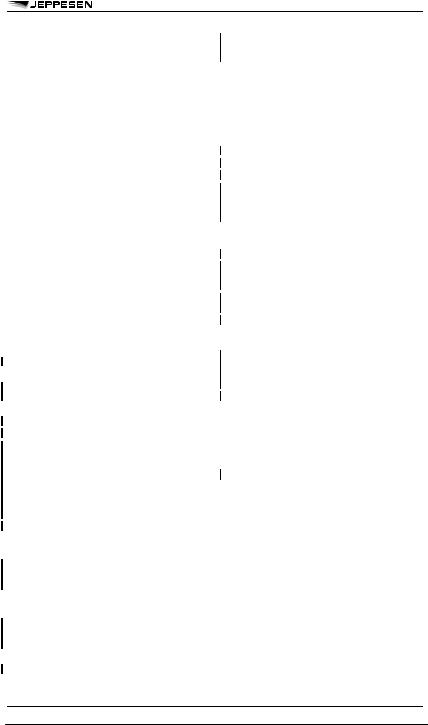
EMERGENCY
.pdf
9 APR 10 |
EMERGENCY |
ISRAEL-1 |
ISRAEL - ICAO DIFFERENCES OR STATE SPECIAL PROCEDURES
GENERAL
In general, the Emergency, Unlawful Interference, Communications Failure, Interception and Search and Rescue procedures are in conformity with the Standards, Recommended Practices and Procedures in ICAO Annexes and Documents.
COMMUNICATIONS FAILURE
EILAT CTR
In VMC: Arriving aircraft shall cross SAMAR at the last assigned speed and altitude, proceed to VORDME ‘LOT’ while descending to 5000ft, then after descending and entering the circuit fly over the runway, re-enter the circuit and land upon signal from Tower.
In IMC: Arriving aircraft shall cross SAMAR at the last assigned speed and altitude. Enter holding over VORDME ‘LOT’ and execute the approach-to-land if possible within 30 minutes from the specified or last acknowledged ETA, whichever is later.
DEPARTURE PROCEDURE FOR JERUSALEM
–ALROD Departures:
Climb to 6000ft to ALROD, then proceed according to flight plan and follow established procedures.
–SIVAK Departures:
Climb to 5000ft to SIVAK, then proceed according to flight plan and follow established procedures.
TEL AVIV (SDE DOV) CTR
Arrivals
In VMC: Arriving aircraft shall fly over the runway and join the circuit upon light signal from the tower.
In IMC: Arriving aircraft shall execute the published Cloud Break Procedure.
Departures
–BGN Departures:
Follow the SID climbing to 5000ft, then proceed according to flight plan and follow established procedures.
–YOSEF Departures:
Follow the SID climbing to 6000ft, then proceed according to flight plan and follow established procedures.
© JEPPESEN, 2003, 2010. ALL RIGHTS RESERVED.

30 JUL 10 |
EMERGENCY |
ITALY-1 |
ITALY - ICAO DIFFERENCES OR STATE SPECIAL PROCEDURES
GENERAL
In general, the Emergency, Unlawful Interference, Communications Failure, Interception and Search and Rescue procedures are in conformity with the Standards, Recommended Practices and Procedures in ICAO Annexes and Documents.
COMMUNICATIONS FAILURE
See RADIO COMMUNICATION FAILURE PROCEDURES EUROPE, and supplemented as follows:
As soon as it is known that two-way communication has failed, ATC shall maintain separation between the aircraft having the communication failure and other aircraft based on the assumption that the aircraft will operate in accordance with VMC or IMC.
Such procedure do not apply when ATC ascertains that the aircraft although not able to transmit is anyhow able to receive and give acknowledgement (transmission of a specified signal or execution of a specified manoeuvre which can be observed by radar).
DESIGNATED NAVIGATIONAL AIDS
The following Aerodrome Navigational Radio Aids have been designated for aircraft experiencing Radio Communication Failure in IMC:
Alghero (Fertilia) |
VOR ‘AEA’ (NDB ‘ALG’ |
|
when VOR ‘AEA’ u/s) |
Amendola |
VOR ‘FGG’ |
Ancona (Falconara) |
Lctr ‘FAL’ |
Bari (Palese Macchie) |
VOR ‘BAR’ |
Bergamo (Orio al Serio) |
VOR ‘BEG’ |
Bologna (Borgo |
NDB ‘BOA’ (VOR ‘BOA’ |
Panigale) |
when NDB u/s) |
Brescia (Montichiari) |
Lctr ‘GAZ’ |
Brindisi (Casale) |
NDB/VOR ‘BRD’ |
Cagliari (Elmas) |
NDB/VOR ‘CAR’ |
Catania (Fontanarossa) |
Points GIGIX (for |
|
RWY 08) or INDAX (for |
|
RWY 26) if a clearance |
|
to the mentioned points |
|
has been received; |
|
NDB/VOR ‘CTF’ if no |
|
such clearance has been |
|
received |
Cuneo (Levaldigi) |
NDB/VOR ‘TOP’ |
Florence (Peretola) |
VOR ‘PRT’ |
Forli |
Lctr ‘FOR’ |
Genoa (Sestri) |
VOR ‘GEN’ |
|
VOR ‘SES’ in case of |
|
VOR ‘GEN’ u/s |
Grosseto |
NDB ‘GRO’ |
Grottaglie |
Lctr ‘GRT’ |
Lamezia Terme |
VOR ‘CDC’ |
|
VOR ‘LMT’ in case of |
|
VOR ‘CDC’ u/s |
Lampedusa |
NDB ‘LPD’ |
Latina |
Lctr/VOR ‘LAT’ |
Milan (Linate) |
The radio aid associated |
|
with the STAR (arrival |
|
route) |
Milan (Malpensa) |
NDB ‘NOV’ to get via |
|
NDB/VOR ’VOG’ or |
|
Lctr/VOR ’SRN’. In |
|
case of NDB ’NOV’ |
|
u/s designated fix for |
|
descent is VERCE or |
|
RIGON according to |
|
planned arrival route |
Montichiari |
VOR ‘BSA’ |
Naples (Capodichino) |
NDB/TVOR ‘POM’ |
Olbia (Costa Smeralda) |
NDB/VOR ‘SME’ |
Palermo (Punta Raisi) |
Lctr/TVOR ‘PRS’. In |
|
case of VOR ’PRS’ |
|
u/s designated fix for |
|
descent is KOLOR. |
Parma |
NDB ’PAR’ |
Perugia |
NDB ’PRU’ |
Pescara |
VOR ‘PES’ |
Pisa (S. Giusto) |
Point JESSY if VOR |
|
equipped, Lctr ‘PIS’ in |
|
other cases |
Reggio Calabria |
TVOR ‘RCA’ (NDB ‘RCA’ |
|
when TVOR u/s) |
Rimini |
NDB/VOR ‘RIM’ |
Rome (Ciampino) |
NDB ‘URB’ (VOR ‘ROM’ |
|
when NDB ‘URB’ u/s) |
Rome (Fiumicino) |
NDB/VOR ‘TAQ’, |
|
NDB/TVOR ‘CMP’ or |
|
VOR ’ROM’, depending |
|
on inbound route |
Torino (Caselle) |
NDB/VOR ‘TOP’ |
Trapani (Birgi) |
NDB ‘TRP’ |
Treviso (S. Angelo) |
Lctr ‘TRE’ |
Trieste (Ronchi dei |
Lctr ‘RON’ |
Legionari) |
|
Verona (Villafranca) |
Lctr ‘GAZ’ |
AVIANO CTR
If a radar vector has been received which deviates from the standard inbound routes, maintain the last assigned and acknowledged level if at or above the minimum holding altitude/minimum holding level for the designated holding point or, if below such level, climb to the minimum prescribed holding altitude/level and comply with ICAO radio failure procedure.
If a radar vector has been received to final approach course and no further ATC transmissions are received, join the TACAN final approach radial or ILS localizer and track inbound, do not cross north of the Aviano TACAN ‘AVI’ R-233 due to rapidly raising terrain.
If a radar vector has been received which deviates from the standard outbound routes, return to published standard outbound routes and comply with ICAO radio failure procedure.
© JEPPESEN, 1989, 2010. ALL RIGHTS RESERVED.

ITALY-2 EMERGENCY 30 JUL 10
ITALY - ICAO DIFFERENCES OR STATE SPECIAL PROCEDURES
GENOA CTR
If no radar vector has been received and the aircraft is following standard inbound routes, proceed from VOR ’GEN’ to VARAP and comply with ICAO radio failure procedures.
If a radar vector has been received, which deviates from the standard inbound routes, maintain the last assigned level if at or above 7000ft, or if below such level climb immediately to 7000ft and proceed to Genoa VOR ‘GEN’, then proceed to the fix VARAP, start the descent and comply with ICAO radio failure procedures.
In the event of radio failure and VOR ’GEN’ u/s or LOC ’GSE’ radio failure, inbound aircraft shall proceed as follows:
a.If no radar vector has been received and the aircraft is following standard inbound routes, from VOR ’SES’ comply with ICAO radio failure procedures.
b.If a radar vector has been received, which deviates from the standard inbound routes, maintain the last assigned level if at or above 6500ft, or if below such level climb immediately to 6500ft and proceed to Sestri VOR ‘SES’, then comply with ICAO radio failure procedures.
ROME TMA
Rome (Ciampino)
When radio failure occurs after aircraft has left IAF Urbe NDB ‘URB’ (or Rome VOR ‘ROM’ in case of Urbe NDB failure), for the approach, if in IMC, the pilot shall proceed as follows:
a.if no radar vector has been received and the aircraft is performing the instrument approach procedure it shall proceed according to the cleared procedure;
b.if a radar vector has been received which deviates from the published instrument approach route, the aircraft shall resume the published route by the shortest way and comply with the instrument approach procedure.
c.if radio failure happens before aircraft has been cleared to IAF, it shall proceed according to published STAR and implement a V procedure if ’URB’ NDB is efficient or a Z procedure in case of ’URB’ NDB unavailability.
SPECIAL PROCEDURES FOR PARALLEL ILS APPROACHES AT ROME (FIUMICINO)
When parallel ILS approaches are in progress for runways 16C and 16R, or 16L and 16R an aircraft experiencing radio failure via ‘TAQ’ must land on runway 16R; an aircraft experiencing radio failure arriving via ‘CMP’ must land on runway 16L or 16C, whichever is in use.
PROCEDURES FOR IFR FLIGHTS (Z AND Y FPL) FROM AND TO AERODROMES IN THE CANTON TICINO (LOCARNO)
Arrival Procedure
Proceed via STAR to PINIK Int. At the last received or acknowledged EAT or, if no EAT has been received or acknowledged, at the flight plan ETA, descend in the PINIK holding to 6000ft.
Carry out a standard instrument approach to RWY 01, followed by a circling approach to RWY 19, if needed.
Departure Procedure
In case of Communication failure the following will apply:
a.if the flight didn’t receive IFR clearance: the flight under VMC may proceed to the departing aerodrome; if under IMC the flight may proceed to LUGAN then PINIK and follow the procedures as shown above (Arrival Procedure).
If the flight received IFR clearance: the flight may proceed to CANNE/Orio Al Serio VORDME ‘ORI’/Saronno VORDME ‘SRN’/Voghera VORDME ’VOG’/OMETO/LUGAN climbing to the last assigned and acknowledged flight level, but not below the Minimum Crossing Altitude.
b.continue to climb to flight level indicated in the flight plan;
c.leave the last assigned and acknowledged flight level or altitude not before three minutes after take-off.
UNLAWFUL INTERFERENCE
a.Unless considerations aboard the aircraft dictate otherwise, the pilot-in-command should attempt to continue flying on the assigned track and at the assigned cruising level at least until able to notify an ATS unit or within radar coverage.
b.When an aircraft subjected to an act of unlawful interference must depart from its assigned cruising level without being able to make radiotelephony contact with ATS, the pilot-in-command should, whenever possible:
1.attempt to broadcast warnings on the VHF emergency frequency and other appropriate frequencies, unless considerations aboard the aircraft indicate otherwise;
2.proceed at a level which differs from the cruising levels normally used for IFR flight in the area by 300m (1000ft) if above FL410 or by 150m (500ft) if below FL410;
3.operate transponder according to ICAO provisions.
© JEPPESEN, 1989, 2010. ALL RIGHTS RESERVED.

8 AUG 08 |
EMERGENCY |
JORDAN-1 |
JORDAN - ICAO DIFFERENCES OR STATE SPECIAL PROCEDURES
GENERAL
In general, the Emergency, Unlawful Interference, Communications Failure, Interception and Search and Rescue procedures are in conformity with the Standards, Recommended Practices and Procedures in ICAO Annexes and Documents.
EMERGENCY
RESCUE AND FIRE FIGHTING SERVICE
Aircraft may communicate with fire fighting vehicles on frequency 121.6MHz at Amman (Queen Alia Intl) airport.
COMMUNICATIONS FAILURE
DEPARTURE PROCEDURE
a.Aircraft experiencing radio failure in the departure phase within the TMA will climb to the level specified in the clearance. If no time or geographical limit was included in the clearance, maintain level for 3 minutes, then continue climb to the flight level specified in the current flight plan after passing the Terminal Exit point, i.e. AMRAH Int, REEMA Int, or Qatraneh VORDME.
b.A departing controlled IFR flight operating in IMC having acknowledged an intermediate clearance to climb to a level other than the one specified in the current flight plan for the enroute phase of the flight, and experiencing radio communication failure, shall, if no time or geographical limit was included in the clearance, maintain for a period of 3 minutes the level to which it was cleared and then continue its flight in accordance with the current flight plan.
NOTE: The level specified in the current flight plan means the level contained in the enroute ACC clearance acknowledged by the pilot.
ARRIVAL PROCEDURE
General
Aircraft inbound to Amman (Marka Intl) or Amman (Queen Alia Intl) will follow published STARs. Strict adherence to these routes is essential as procedural separation between inbound and outbound aircraft is based on these criteria.
Westerly Operations
In case of communication failure the designated navigational aid to be used for holding is the Queen Alia VORDME ‘QAA’. After arrival over the Queen Alia VORDME ’QAA’ commence descent at or as close as possible to the EAT last received and acknowledged or as close as possible to the ETA given in the current flight plan if no EAT has been received.
–Inbounds to Amman (Marka Intl) will descend in the Queen Alia VORDME holding pattern. When at 6000ft set course for VORDME ‘AMN’ on Amman R-162 and complete the normal instrument approach procedure published for VORDME ‘AMN’ and land if possible within 30 minutes of the last acknowledged EAT or ETA whichever is later.
–Inbounds to Amman (Queen Alia Intl) will complete the normal instrument approach procedure published for VORDME ‘QAA’ and land if possible within 30 minutes of the last acknowledged EAT or ETA whichever is later.
Easterly Operations via A412
In case of communication failure the designated navigational aid to be used for holding is the Amman VORDME ’AMN’ for inbounds on A412 via AMRAH Int. After arrival over the Amman VORDME ’AMN’ commence descent at or as close as possible to the ETA given in the current flight plan in no EAT has been received.
–Inbounds to Amman (Marka Intl) will complete the normal instrument approach procedure published for VORDME ‘AMN’ and land if possible within 30 minutes of the last acknowledged EAT or ETA whichever is later.
–Inbounds to Amman (Queen Alia Intl) will continue in accordance with the AMRAH 3E STAR profile then descent to 6000ft and carry out the instrument approach procedure via Madaba NDB ‘MDB’ and land if possible within 30 minutes of the last acknowledged EAT or ETA whichever is later.
Easterly Operations via R652
In case of communication failure the designated navigational aid to be used for holding is the Qatraneh VORDME ’QTR’ for inbound on R652 via VORDME ‘QTR’ and REEMA Int. After arrival over ’QTR’ descend in the holding pattern to 11000ft at or as close as possible to the EAT last received and acknowledged or as close as possible to the ETA given in the current flight plan. If no EAT has been received when leveling 11000ft proceed as follows:
–Inbounds to Amman (Marka Intl) will continue in accordance with the STAR QATRANEH or REEMA 5E profile and carry out the instrument approach procedure published for VORDME ‘AMN’ and land if possible within 30 minutes of the last acknowledged EAT or ETA whichever is later.
–Inbounds to Amman (Queen Alia Intl) will continue in accordance with the STAR QATRANEH or REEMA 3E profile and carry out the instrument approach procedure via Madaba NDB ‘MDB’ and land if possible within 30 minutes of the last acknowledged EAT or ETA whichever is later.
© JEPPESEN, 1993, 2008. ALL RIGHTS RESERVED.

17 APR 09 |
EMERGENCY |
LEBANON-1 |
LEBANON - ICAO DIFFERENCES OR STATE SPECIAL PROCEDURES
GENERAL
In general, the Emergency, Unlawful Interference, Communications Failure, Interception and Search and Rescue procedures are in conformity with the Standards, Recommended Practices and Procedures in ICAO Annexes and Documents.
COMMUNICATIONS FAILURE
TRAFFIC UNDER RADAR CONTROL
Aircraft under radar control experiencing radio failure shall select Mode A Code 7600 and maintain the last assigned heading and level for a period of three minutes, after which time the general ICAO procedures shall apply.
SPECIAL PROCEDURES IN BEIRUT
CONTROLLED AREA FOR ARRIVING AND DEPARTING AIRCRAFT
In case of ground navigation aids or radar failures, IFR and VFR flights are accepted to operate within Beirut Controlled Airspace A, B and C provided that:
–such flights are able to use aircraft satellite based navigation aids (RNAV, GPS ...etc.);
–the aircraft can commence approach and landing in VMC when the ceiling ist at or above the minimum initial altitude, and
–the pilot can maintain visual reference to the terrain, and there is a reasonable assurance that a visual approach and landing can be completed during day and night.
© JEPPESEN, 1993, 2009. ALL RIGHTS RESERVED.

27 MAR 09 |
EMERGENCY |
MALTA-1 |
MALTA - ICAO DIFFERENCES OR STATE SPECIAL PROCEDURES
GENERAL
In general, the Emergency, Unlawful Interference, Communications Failure, Interception and Search and Rescue procedures are in conformity with the Standards, Recommended Practices and Procedures in ICAO Annexes and Documents.
COMMUNICATIONS FAILURE
See RADIO COMMUNICATION FAILURE PROCEDURES EUROPE.
© JEPPESEN, 1989, 2009. ALL RIGHTS RESERVED.

30 JAN 09 |
EMERGENCY |
MONTENEGRO-1 |
MONTENEGRO - ICAO DIFFERENCES OR STATE SPECIAL PROCEDURES
GENERAL
In general, the Emergency, Unlawful Interference, Communications Failure, Interception and Search and Rescue procedures are in conformity with the Standards, Recommended Practices and Procedures in ICAO Annexes and Documents.
COMMUNICATIONS FAILURE
See RADIO COMMUNICATION PROCEDURES EUROPE.
INTERCEPTION PROCEDURES
© JEPPESEN, 2009. ALL RIGHTS RESERVED.

MONTENEGRO-2 |
EMERGENCY |
30 JAN 09 |
MONTENEGRO - ICAO DIFFERENCES OR STATE SPECIAL PROCEDURES
© JEPPESEN, 2009. ALL RIGHTS RESERVED.

12 NOV 10 |
EMERGENCY |
NETHERLANDS-1 |
NETHERLANDS - ICAO DIFFERENCES OR STATE SPECIAL PROCEDURES
GENERAL
In general, the Emergency, Unlawful Interference, Communications Failure, Interception and Search and Rescue procedures are in conformity with the Standards, Recommended Practices and Procedures in ICAO Annexes and Documents.
COMMUNICATIONS FAILURE
GENERAL PROCEDURES FOR IFR FLIGHTS
Flying in IMC
Pilots of an IFR flight in IMC, or not able to comply with Flying in VMC procedures, shall:
a.select code 7600.
b.in case of radar vectoring, proceed as directly as possible to the route specified in the current flight plan (Note 1).
c.maintain for a period of 7 minutes (Note 2) the last assigned speed and level, or minimum flight altitude if this is higher. The period of 7 minutes commences at the time the transponder is set to code 7600.
d.subsequently adjust speed and level as specified in the filed flight plan (Note 3).
Note 1: With regard to the route to be flown, the current flight plan (including subsequent changes) will be used.
Note 2: The period of 7 minutes is to allow the necessary air traffic control and co-ordination measures.
Note 3: With regard to levels and speed, the filed flight plan (as initially filed by the pilot) will be used.
Flying in VMC
The pilot of an IFR flight in VMC shall:
a.select transponder code 7600.
b.continue to fly in VMC.
c.land at the nearest suitable aerodrome; and
d.report its arrival time by the most expeditious means to the appropriate ATS unit.
ARRIVING FLIGHTS
For IFR flights with a destination situated in the Amsterdam FIR see AIRPORT BRIEFING pages.
© JEPPESEN, 1987, 2010. ALL RIGHTS RESERVED.

31 JUL 09 |
EMERGENCY |
NORWAY-1 |
NORWAY - ICAO DIFFERENCES OR STATE SPECIAL PROCEDURES
GENERAL
In general, the Emergency, Unlawful Interference, Communications Failure, Interception and Search and Rescue procedures are in conformity with the Standards, Recommended Practices and Procedures in ICAO Annexes and Documents.
COMMUNICATIONS FAILURE
See RADIO COMMUNICATION FAILURE PROCEDURES EUROPE supplemented as follows:
DESIGNATED NAVIGATIONAL AIDS
The facilities listed below have been designated as appropriate navigational aids to be used by aircraft experiencing radio communication failure, but will not become applicable if the aircraft has received clearance to another navigational aid at or on the vicinity of the aerodrome and the aircraft either:
a.has cleared for approach from that navigational aid,
b.has received information indicating that a clearance for approach from (via) that navigational aid can be expected, or
c.consider it obvious that ATC expects approach to be started from the navigational aid to which the aircraft has been cleared.
Aerodrome |
Facility |
Alesund (Vigra) |
VOR ’VIG’ |
Alta |
VOR ’ATA’ |
Andenes (Andoya) |
VOR ’AND’ |
Bardufoss |
NDB ’TIL’ |
Bergen (Flesland) |
VOR ’FLS’ |
Bodo |
VOR ’BDO’ |
Harstad-Narvik (Evenes) |
NDB ’FS’ |
Haugesund (Karmoy) |
NDB ’FNO’ |
Kirkenes (Hoybuktmoen) |
VOR ’KIK’ |
Kristiansand (Kjevik) |
VOR ’SVA’ |
Kristiansund |
NDB ’BRS’ |
(Kvernberget) |
|
Lakselv (Banak) |
NDB ’BNR’ |
Molde (Aro) |
NDB ’TAT’ |
Moss (Rygge) |
NDB ’RG’ |
Orland |
NDB ’TAR’ |
Oslo (Gardermoen) |
NDB ’BGU’ |
Roros |
NDB ’RBU’ |
Sandefjord (Torp) |
NDB ’DA’ |
Stavanger (Sola) |
VOR ’ZOL’ |
Tromso (Langnes) |
VOR ’TRO’ |
Trondheim (Vaernes) |
NDB ’GRK’ |
COMMUNICATION FAILURE FOR CONTROLLED IFR FLIGHTS
Departing controlled IFR flights experiencing communication failure when in IMC should in compliance with the general provisions applicable in such cases, proceed as follows:
a.if a temporary climb restriction has been imposed, climb to and maintain the assigned level to the point where it has been indicated that further climb can be expected, and when passing this point climb to the cruising level specified in the current flight plan.
b.if a clearance to a temporary intermediate level has been issued and no point where further climb can be expected has been specified, climb to and maintain the last assigned level, or minimum flight altitude if higher, for 7 minutes before continuing climb to the cruising level in accordance with the filed flight plan.
AIRCRAFT BEING RADAR VECTORED OR PROCEEDING OFFSET ACCORDING
TO RNAV
If an aircraft is vectored by radar or proceeding offset according to RNAV without a specified limit, and it experiences communication failure, it shall proceed in the most direct manner possible to rejoin the current flight plan route no later than the next significant point, taking into consideration the applicable minimum flight altitude.
ARRIVAL PROCEDURE FOR ALESUND (VIGRA) RWY 07 AND 25
Continue on STAR and start approach to runway-in- use without delay.
DEPARTURE PROCEDURE FOR ALESUND (VIGRA) RWY 07 AND 25
Maintain the last cleared and acknowledged level until passing 15 DME ‘VIG’, then climb to the cruising level indicated in the current flight plan. After completion of the SID proceed via the most direct route to join the cleared ATS route.
Aircraft under radar vectoring shall, after having set the transponder to A7600, continue on heading last cleared and acknowledged for 2 minutes, then proceed via the most direct route to join the cleared ATS route.
DEPARTURE PROCEDURE FOR ALTA RWY 11 AND 29
Maintain last cleared and acknowledged level until passing 25 DME ‘ATA’. Then climb to the cruising level stated in the current flight plan.
DEPARTURE PROCEDURE FOR
BARDUFOSS RWY 10 AND 28
Maintain the last cleared and acknowledged level until passing 20 DME ‘BDF’, then climb to the cruising level indicated in the current flight plan. After completion of the SID proceed via the most direct route to join the cleared ATS route.
ARRIVAL PROCEDURE FOR BERGEN (FLESLAND) RWY 17 AND 35
Continue on STAR and start approach to runway-in- use without delay.
© JEPPESEN, 1993, 2009. ALL RIGHTS RESERVED.
